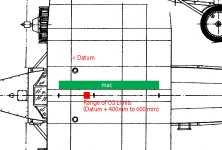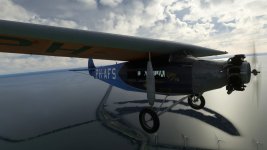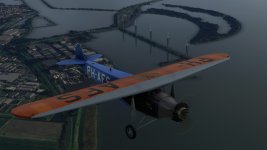I have been flying it tonight and here is a brief review.
There are five versions in total, the F.VIIa/1m single-engine version, the F.VIIb/3m Southern Cross, the F.VIIb/3m on skis, the F.VIIb/3m on floats, and the F.VIIb/3m "Retrofit" with modern cockpit. All of them have only one skin except for the Retrofit, which comes with 8 skins, a Southern Cross, a "generic" (Southern Cross colors but without lettering on it), four nice vintage airline schemes, and two stupid Aviators Club schemes. The model for the Southern Cross and generic /3ms have the modified angular vertical tail, whereas the others have the more standard comma-shaped tail. Weirdly, they did not provide a standard airliner trimotor version with the vintage cockpit. However, I found that you can swap the cockpits by editing each livery's model.cfg file so that it uses the old cockpit rather than the new one. Hopefully word about this will get around so that repainters are not deterred from doing the many fabulous skins that could be done for the standard airliner.
The modern cockpit is really modern, steam gauge but very up-to-date with a lot more dials and switches. I haven't tested whether they all function, but the overall impression is one of overkill. It's not convincing as a vintage aircraft with its instruments updated by a modern restorer, it's more like how the cockpit would be set up if these aircraft were still in airline service circa 1980 or so. The vintage cockpit is very straightforward, the same one is used for all of the /3ms, and it's functional but I find it odd that there are no manifold pressure gauges. The /1m has a different cockpit which is even simpler but again has no m.p. gauge.
The models and texturing are to a high standard. The sounds are quite nice.
Flight characteristics seem pretty decent. The CG limits on the weight and balance screen are useless, giving no guidance as to the allowable range, but an empty airplane defaults to a CG of about 5% MAC which is definitely out of range. Move the slider so that your CG is at least 25% MAC if you would like to have any ability to flare on landing. The plane feels appropriately heavy and stable apart from the usual MSFS twitchiness on the runway. On landing it shows down and stops nicely. I would say the flight model is better than the Ju 52 that was released with the Germany WU.
The biggest disappointment is the /1m, which is far underpowered and will barely struggle off the ground, even when empty. There's no peeking at the encrypted flight model, but the target_performance.cfg file calls for a max hp of 300, which is wrong. F.VIIa/1ms were engined with anything from 360 to 480 hp, with 450 hp being the most common. So, poor show on Orbx for not properly researching this interesting variant, and they couldn't have flight tested it, either. It was satisfying the first time I coaxed one up to a safe altitude, but it shouldn't have been that difficult. This is the one thing I've found that really cries out for a fix. But given the history of these partnered airplanes, I won't hold my breath waiting for one.
Overall, except for the anemic single engined variant, I'd say it's a nice plane and good value for money.
August
















 On my second flight I tried the same "tactics" only with load and more fuel. All pax on board and 65% fuel load. Ended up trimming treetops and hedges and well didn´t get very far...
On my second flight I tried the same "tactics" only with load and more fuel. All pax on board and 65% fuel load. Ended up trimming treetops and hedges and well didn´t get very far...